NISSAN ALTIMA 2019 Owner´s Manual
Manufacturer: NISSAN, Model Year: 2019, Model line: ALTIMA, Model: NISSAN ALTIMA 2019Pages: 592, PDF Size: 7.4 MB
Page 571 of 592
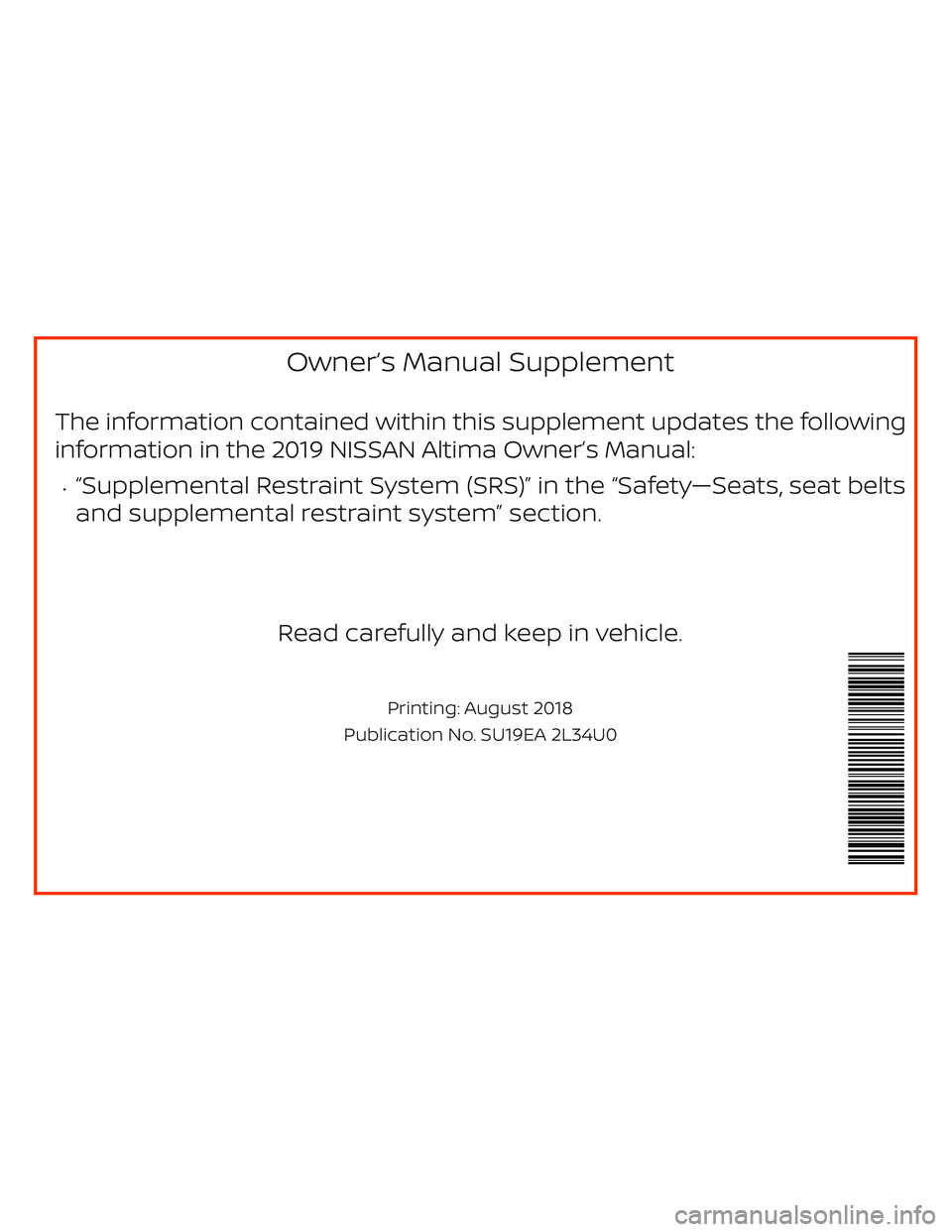
Owner’s Manual Supplement
The information contained within this supplement updates the following
information in the 2019 NISSAN Altima Owner’s Manual:
∙“Supplemental Restraint System (SRS)” in the “Safety—Seats, seat belts
and supplemental restraint system” section.
Read carefully and keep in vehicle.
Printing: August 2018
Publication No. SU19EA 2L34U0
Page 572 of 592
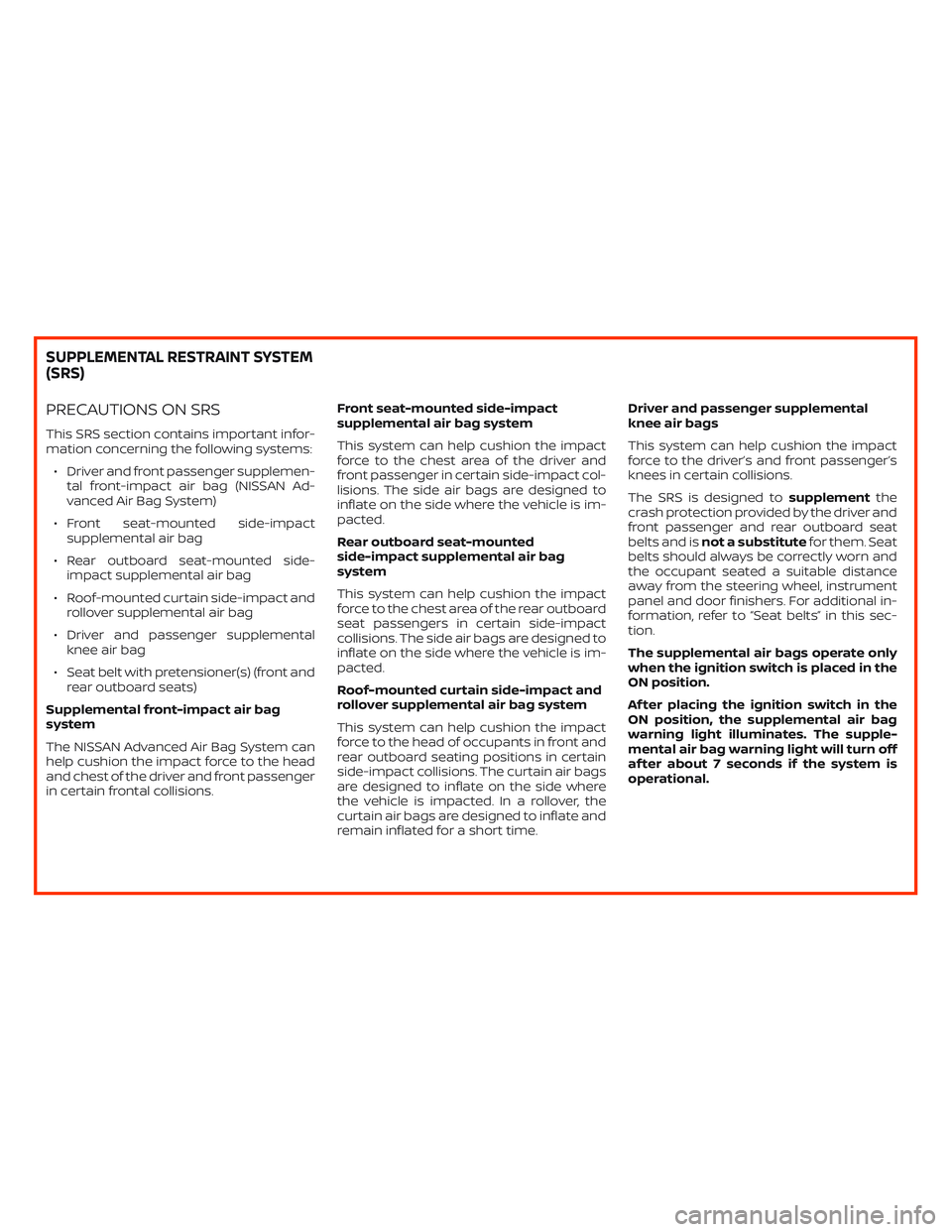
PRECAUTIONS ON SRS
This SRS section contains important infor-
mation concerning the following systems:
‚àô Driver and front passenger supplemen-
tal front-impact air bag (NISSAN Ad-
vanced Air Bag System)
‚àô Front seat-mounted side-impact
supplemental air bag
‚àô Rear outboard seat-mounted side-
impact supplemental air bag
‚àô Roof-mounted curtain side-impact and
rollover supplemental air bag
‚àô Driver and passenger supplemental
knee air bag
‚àô Seat belt with pretensioner(s) (front and
rear outboard seats)
Supplemental front-impact air bag
system
The NISSAN Advanced Air Bag System can
help cushion the impact force to the head
and chest of the driver and front passenger
in certain frontal collisions.Front seat-mounted side-impact
supplemental air bag system
This system can help cushion the impact
force to the chest area of the driver and
front passenger in certain side-impact col-
lisions. The side air bags are designed to
inflate on the side where the vehicle is im-
pacted.
Rear outboard seat-mounted
side-impact supplemental air bag
system
This system can help cushion the impact
force to the chest area of the rear outboard
seat passengers in certain side-impact
collisions. The side air bags are designed to
inflate on the side where the vehicle is im-
pacted.
Roof-mounted curtain side-impact and
rollover supplemental air bag system
This system can help cushion the impact
force to the head of occupants in front and
rear outboard seating positions in certain
side-impact collisions. The curtain air bags
are designed to inflate on the side where
the vehicle is impacted. In a rollover, the
curtain air bags are designed to inflate and
remain inflated for a short time.Driver and passenger supplemental
knee air bags
This system can help cushion the impact
force to the driver’s and front passenger’s
knees in certain collisions.
The SRS is designed tosupplementthe
crash protection provided by the driver and
front passenger and rear outboard seat
belts and isnot a substitutefor them. Seat
belts should always be correctly worn and
the occupant seated a suitable distance
away from the steering wheel, instrument
panel and door finishers. For additional in-
formation, refer to “Seat belts” in this sec-
tion.
The supplemental air bags operate only
when the ignition switch is placed in the
ON position.
Af ter placing the ignition switch in the
ON position, the supplemental air bag
warning light illuminates. The supple-
mental air bag warning light will turn off
af ter about 7 seconds if the system is
operational.
SUPPLEMENTAL RESTRAINT SYSTEM
(SRS)
Page 573 of 592
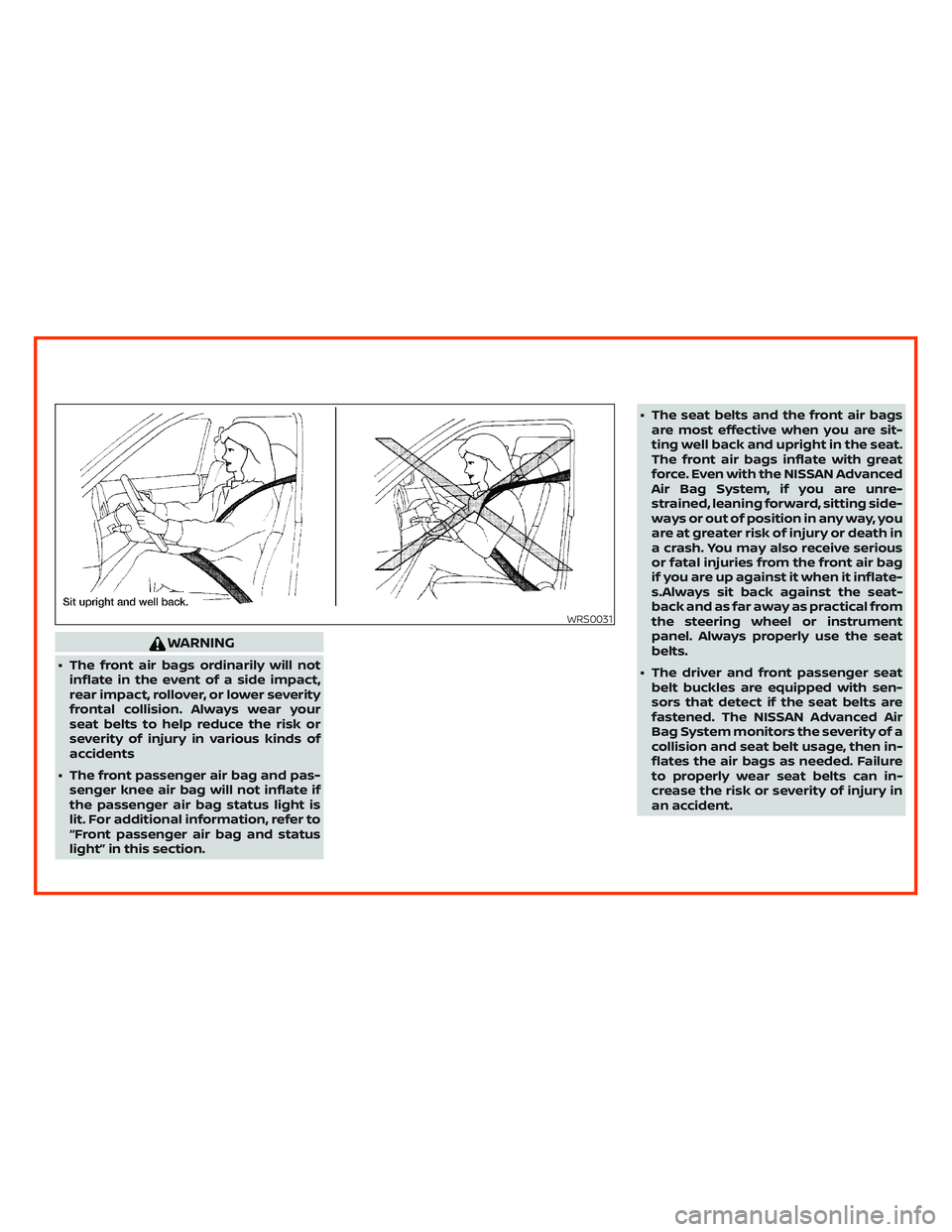
WARNING
‚àô The front air bags ordinarily will not
inflate in the event of a side impact,
rear impact, rollover, or lower severity
frontal collision. Always wear your
seat belts to help reduce the risk or
severity of injury in various kinds of
accidents
‚àô The front passenger air bag and pas-
senger knee air bag will not inflate if
the passenger air bag status light is
lit. For additional information, refer to
“Front passenger air bag and status
light” in this section.∙ The seat belts and the front air bags
are most effective when you are sit-
ting well back and upright in the seat.
The front air bags inflate with great
force. Even with the NISSAN Advanced
Air Bag System, if you are unre-
strained, leaning forward, sitting side-
ways or out of position in any way, you
are at greater risk of injury or death in
a crash. You may also receive serious
or fatal injuries from the front air bag
if you are up against it when it inflate-
s.Always sit back against the seat-
back and as far away as practical from
the steering wheel or instrument
panel. Always properly use the seat
belts.
‚àô The driver and front passenger seat
belt buckles are equipped with sen-
sors that detect if the seat belts are
fastened. The NISSAN Advanced Air
Bag System monitors the severity of a
collision and seat belt usage, then in-
flates the air bags as needed. Failure
to properly wear seat belts can in-
crease the risk or severity of injury in
an accident.
WRS0031
Page 574 of 592
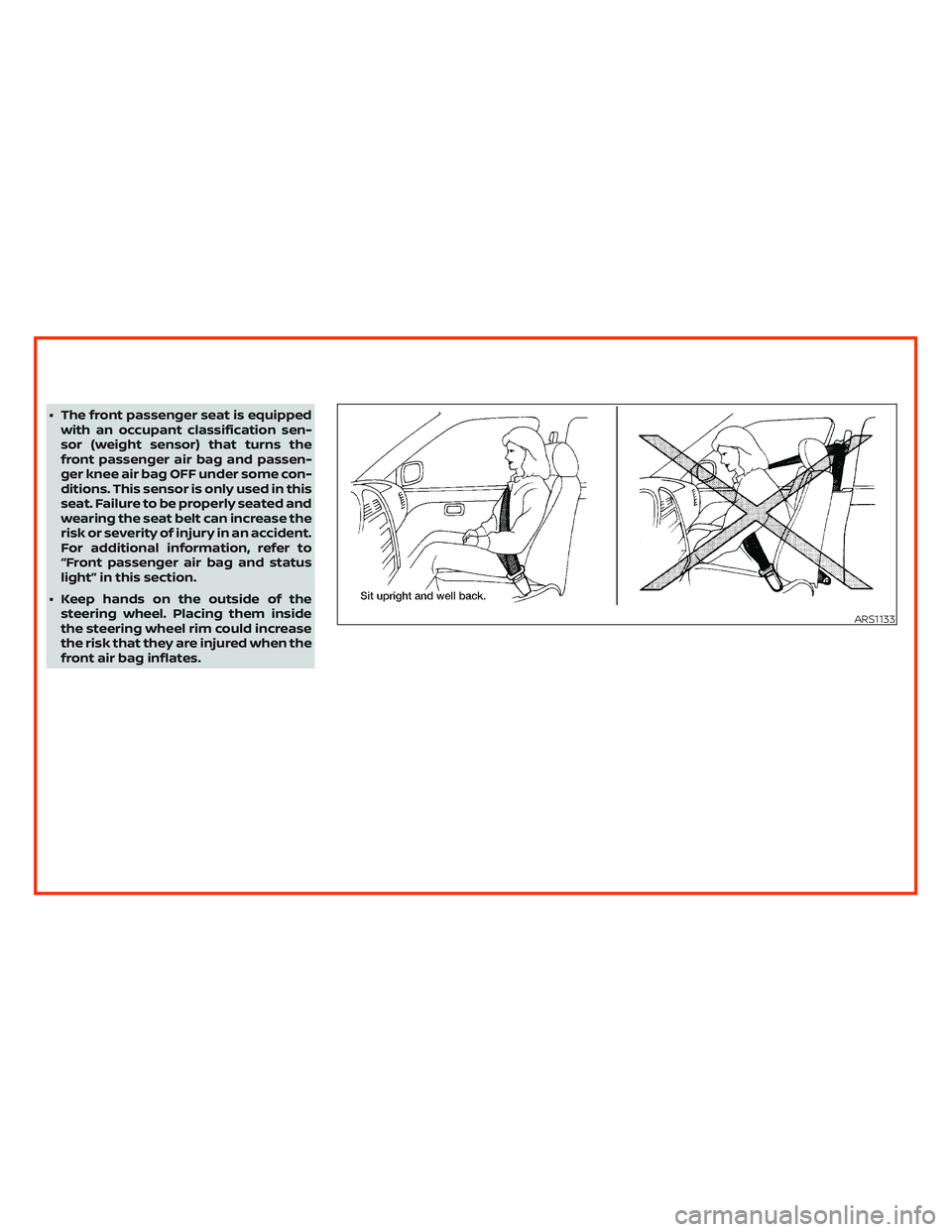
‚àô The front passenger seat is equipped
with an occupant classification sen-
sor (weight sensor) that turns the
front passenger air bag and passen-
ger knee air bag OFF under some con-
ditions. This sensor is only used in this
seat. Failure to be properly seated and
wearing the seat belt can increase the
risk or severity of injury in an accident.
For additional information, refer to
“Front passenger air bag and status
light” in this section.
‚àô Keep hands on the outside of the
steering wheel. Placing them inside
the steering wheel rim could increase
the risk that they are injured when the
front air bag inflates.
ARS1133
Page 575 of 592
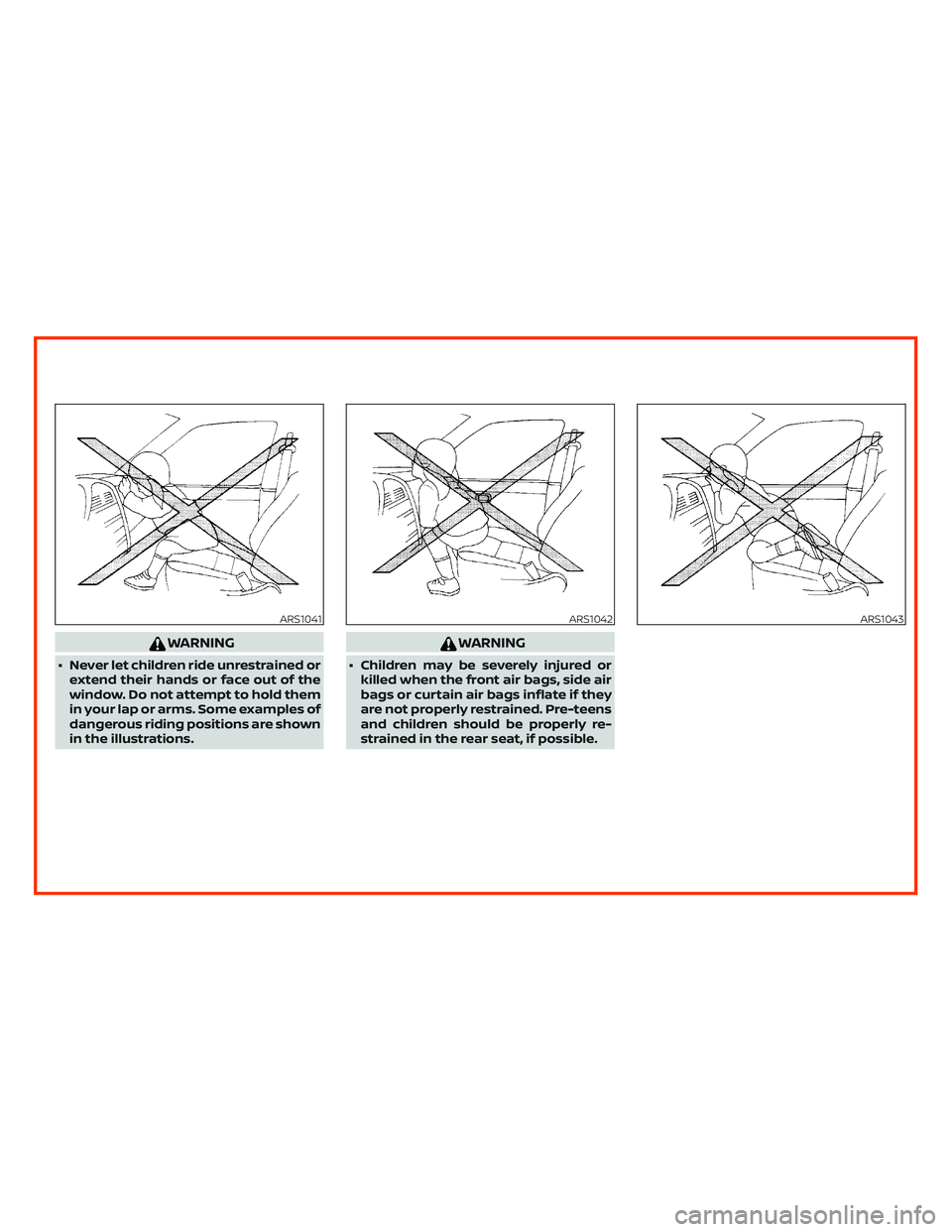
WARNING
‚àô Never let children ride unrestrained or
extend their hands or face out of the
window. Do not attempt to hold them
in your lap or arms. Some examples of
dangerous riding positions are shown
in the illustrations.
WARNING
‚àô Children may be severely injured or
killed when the front air bags, side air
bags or curtain air bags inflate if they
are not properly restrained. Pre-teens
and children should be properly re-
strained in the rear seat, if possible.
ARS1041ARS1042ARS1043
Page 576 of 592
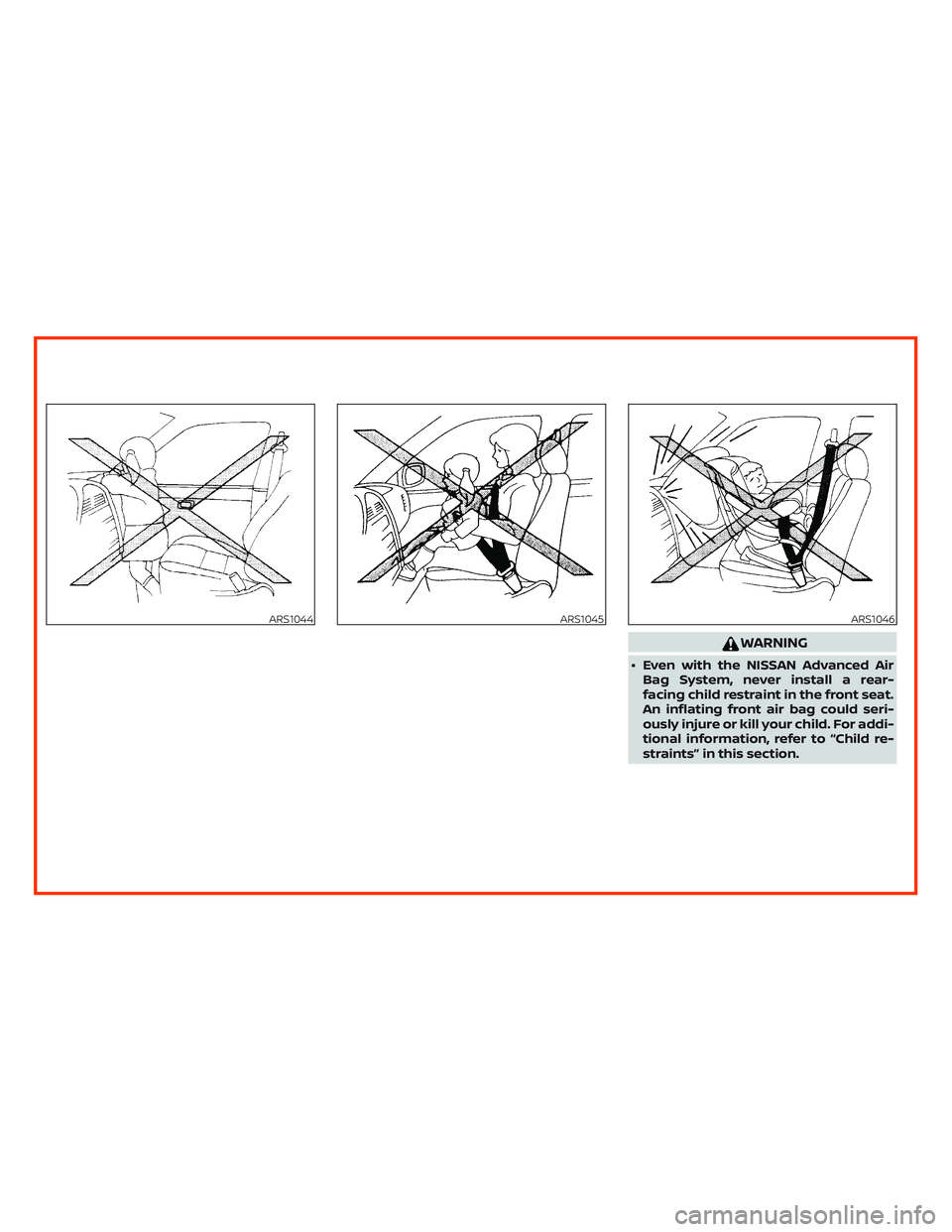
WARNING
‚àô Even with the NISSAN Advanced Air
Bag System, never install a rear-
facing child restraint in the front seat.
An inflating front air bag could seri-
ously injure or kill your child. For addi-
tional information, refer to “Child re-
straints” in this section.
ARS1044ARS1045ARS1046
Page 577 of 592
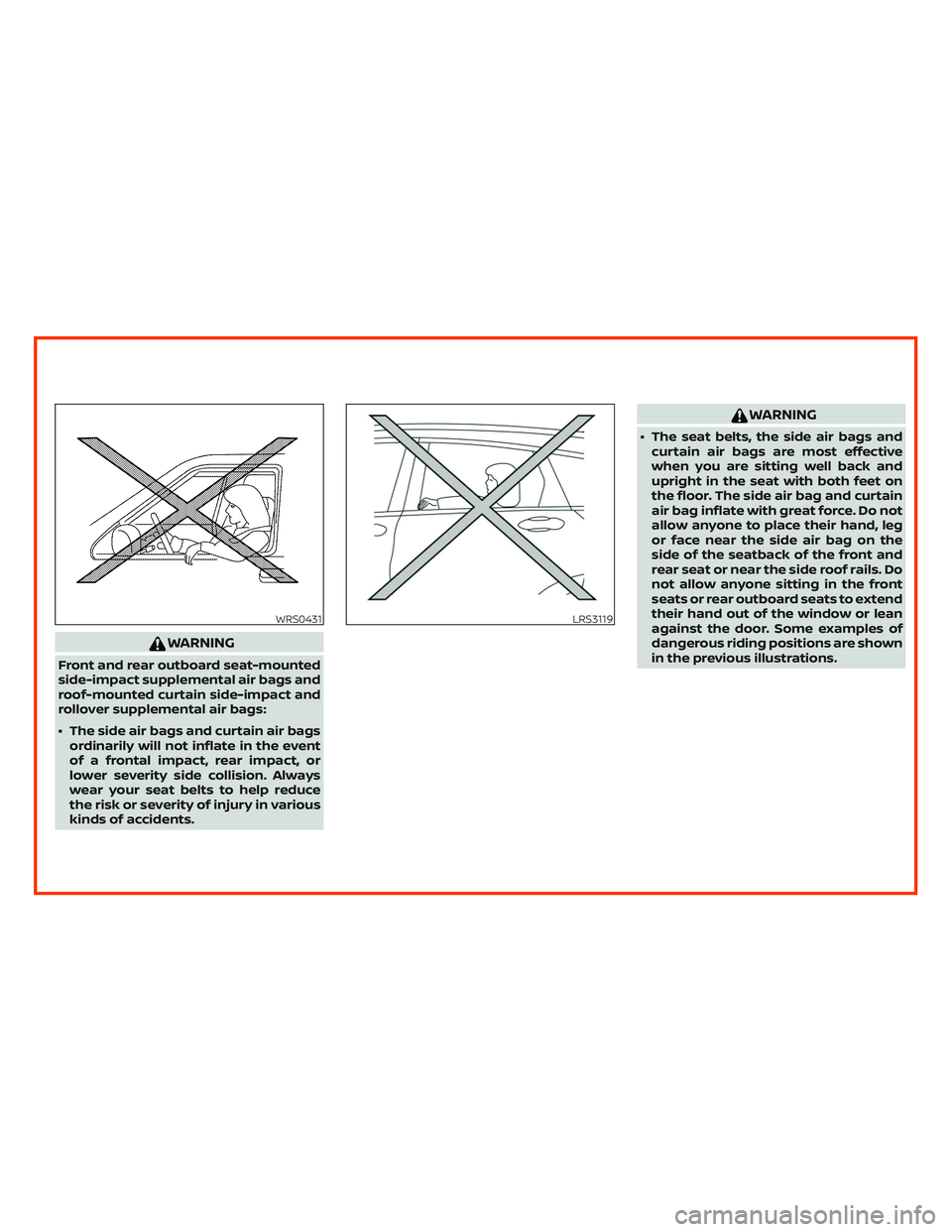
WARNING
Front and rear outboard seat-mounted
side-impact supplemental air bags and
roof-mounted curtain side-impact and
rollover supplemental air bags:
‚àô The side air bags and curtain air bags
ordinarily will not inflate in the event
of a frontal impact, rear impact, or
lower severity side collision. Always
wear your seat belts to help reduce
the risk or severity of injury in various
kinds of accidents.
WARNING
‚àô The seat belts, the side air bags and
curtain air bags are most effective
when you are sitting well back and
upright in the seat with both feet on
the floor. The side air bag and curtain
air bag inflate with great force. Do not
allow anyone to place their hand, leg
or face near the side air bag on the
side of the seatback of the front and
rear seat or near the side roof rails. Do
not allow anyone sitting in the front
seats or rear outboard seats to extend
their hand out of the window or lean
against the door. Some examples of
dangerous riding positions are shown
in the previous illustrations.
WRS0431LRS3119
Page 578 of 592
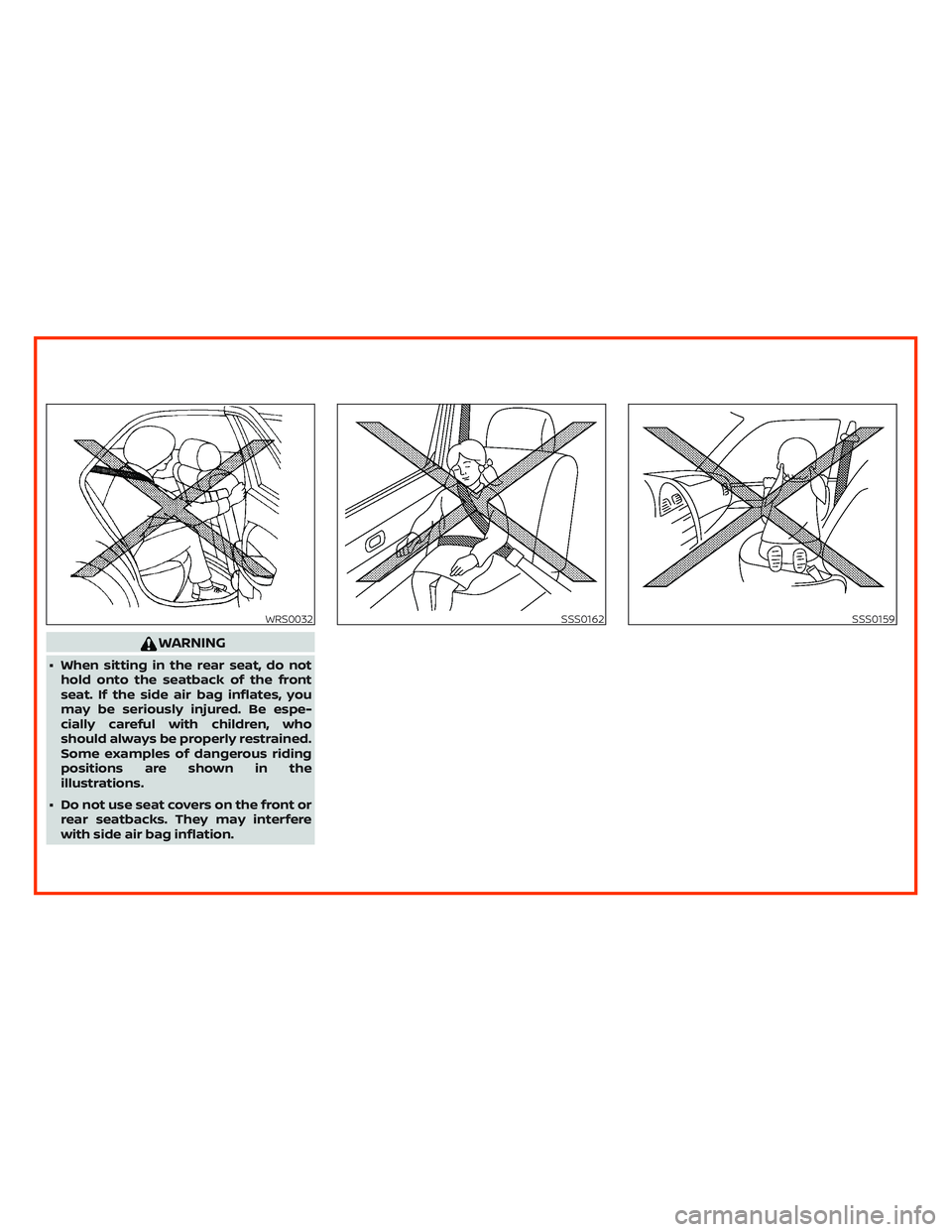
WARNING
‚àô When sitting in the rear seat, do not
hold onto the seatback of the front
seat. If the side air bag inflates, you
may be seriously injured. Be espe-
cially careful with children, who
should always be properly restrained.
Some examples of dangerous riding
positions are shown in the
illustrations.
‚àô Do not use seat covers on the front or
rear seatbacks. They may interfere
with side air bag inflation.
WRS0032SSS0162SSS0159
Page 579 of 592
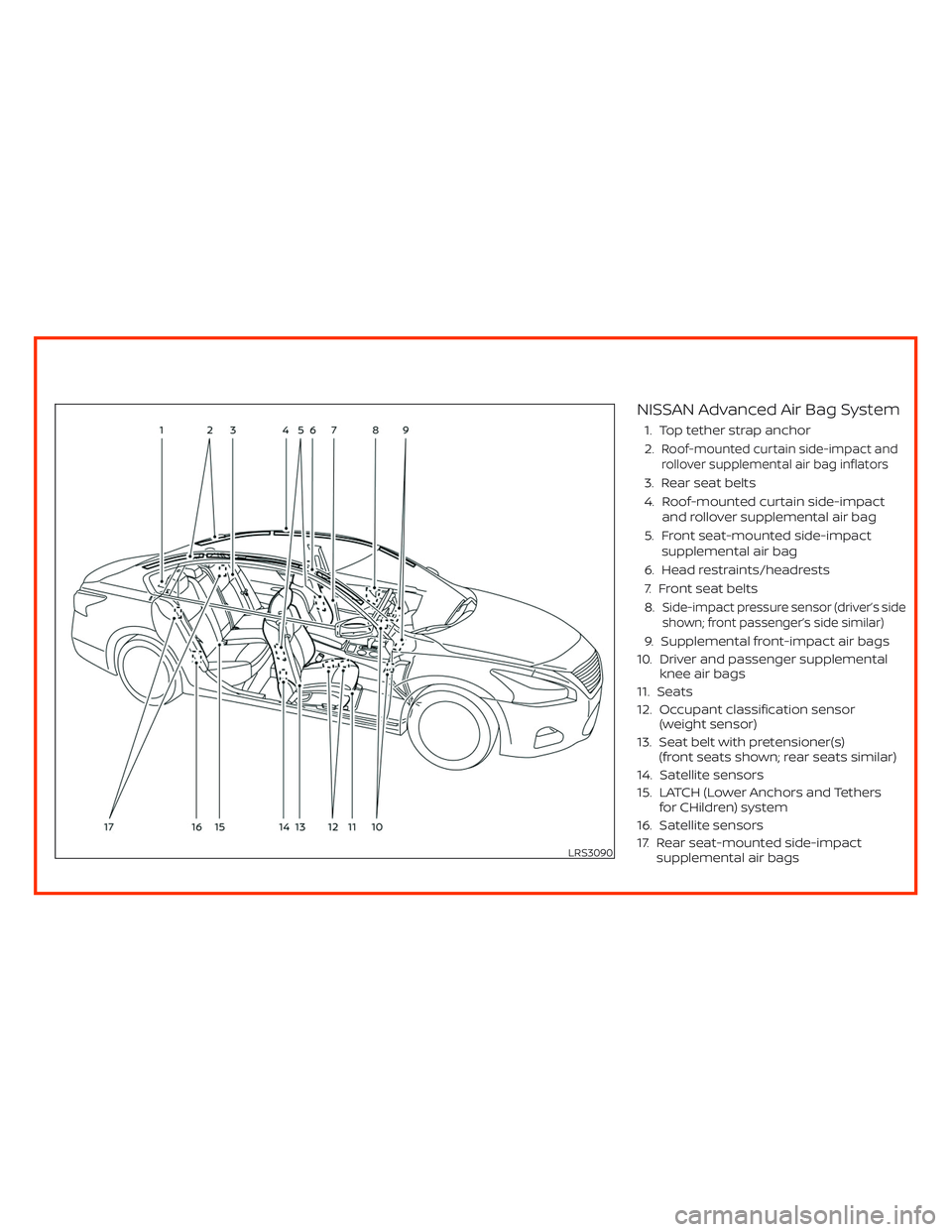
NISSAN Advanced Air Bag System
1. Top tether strap anchor
2.
Roof-mounted curtain side-impact and
rollover supplemental air bag inflators
3. Rear seat belts
4. Roof-mounted curtain side-impact
and rollover supplemental air bag
5. Front seat-mounted side-impact
supplemental air bag
6. Head restraints/headrests
7. Front seat belts
8.
Side-impact pressure sensor (driver’s side
shown; front passenger’s side similar)
9. Supplemental front-impact air bags
10. Driver and passenger supplemental
knee air bags
11. Seats
12. Occupant classification sensor
(weight sensor)
13. Seat belt with pretensioner(s)
(front seats shown; rear seats similar)
14. Satellite sensors
15. LATCH (Lower Anchors and Tethers
for CHildren) system
16. Satellite sensors
17. Rear seat-mounted side-impact
supplemental air bags
LRS3090
Page 580 of 592
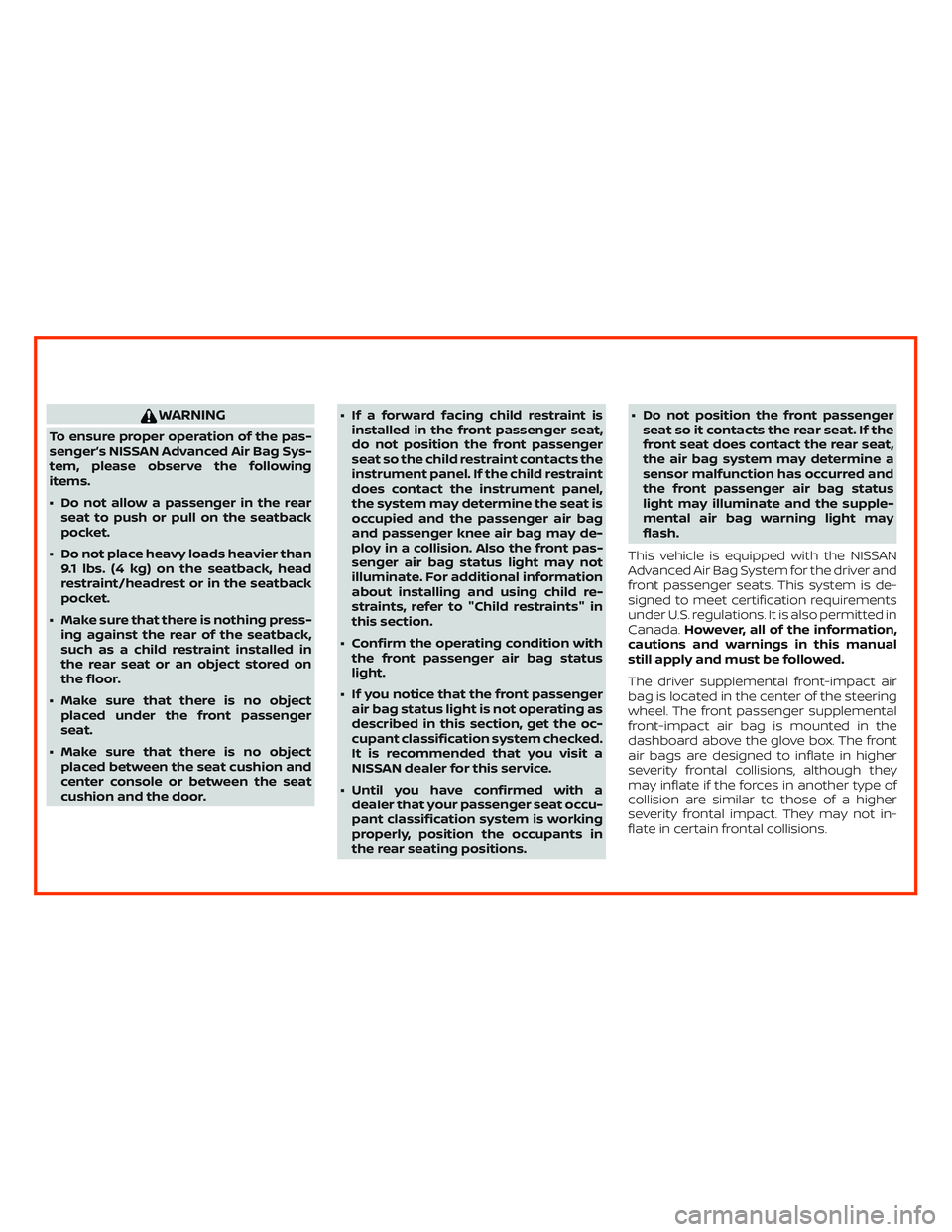
WARNING
To ensure proper operation of the pas-
senger’s NISSAN Advanced Air Bag Sys-
tem, please observe the following
items.
‚àô Do not allow a passenger in the rear
seat to push or pull on the seatback
pocket.
‚àô Do not place heavy loads heavier than
9.1 lbs. (4 kg) on the seatback, head
restraint/headrest or in the seatback
pocket.
‚àô Make sure that there is nothing press-
ing against the rear of the seatback,
such as a child restraint installed in
the rear seat or an object stored on
the floor.
‚àô Make sure that there is no object
placed under the front passenger
seat.
‚àô Make sure that there is no object
placed between the seat cushion and
center console or between the seat
cushion and the door.‚àô If a forward facing child restraint is
installed in the front passenger seat,
do not position the front passenger
seat so the child restraint contacts the
instrument panel. If the child restraint
does contact the instrument panel,
the system may determine the seat is
occupied and the passenger air bag
and passenger knee air bag may de-
ploy in a collision. Also the front pas-
senger air bag status light may not
illuminate. For additional information
about installing and using child re-
straints, refer to "Child restraints" in
this section.
‚àô Confirm the operating condition with
the front passenger air bag status
light.
‚àô If you notice that the front passenger
air bag status light is not operating as
described in this section, get the oc-
cupant classification system checked.
It is recommended that you visit a
NISSAN dealer for this service.
‚àô Until you have confirmed with a
dealer that your passenger seat occu-
pant classification system is working
properly, position the occupants in
the rear seating positions.‚àô Do not position the front passenger
seat so it contacts the rear seat. If the
front seat does contact the rear seat,
the air bag system may determine a
sensor malfunction has occurred and
the front passenger air bag status
light may illuminate and the supple-
mental air bag warning light may
flash.
This vehicle is equipped with the NISSAN
Advanced Air Bag System for the driver and
front passenger seats. This system is de-
signed to meet certification requirements
under U.S. regulations. It is also permitted in
Canada.However, all of the information,
cautions and warnings in this manual
still apply and must be followed.
The driver supplemental front-impact air
bag is located in the center of the steering
wheel. The front passenger supplemental
front-impact air bag is mounted in the
dashboard above the glove box. The front
air bags are designed to inflate in higher
severity frontal collisions, although they
may inflate if the forces in another type of
collision are similar to those of a higher
severity frontal impact. They may not in-
flate in certain frontal collisions.